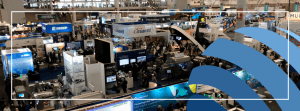
If some people talk about hitting the ground running at a new job, then I entered this one at a dead sprint. With just three days of onboarding under my belt I packed my best blazers and comfiest heels and flew four hours northeast to Boston, MA. Two hours after landing, I headed into my first meeting.
This was my first seafood show, and actually my first work trip ever. I’d heard people talk about Seafood Expo North America, the biggest seafood conference in the states, but I still walked in unprepared for the magnitude of the event.
As anyone who has been to SENA knows, the experience can be hugely overwhelming if you let it be (and sometimes even when you do your best not to). Over the course of our four days in Boston we had 27 meetings, three conference sessions, and walked the length of the exhibit hall at least four times. I won’t attempt to recall every person I met that week, but given the dozens of business cards I collected, the number must have been significant. In short, we were busy.
Through it all, though, we made great use of the in-person time we got. Not only did I get to meet Daniel, GTA’s fearless leader and my new boss, face-to-face, I also met eight of our wonderful industry Partners and several NGO collaborators. I got a head-first crash course on the GTA’s impact and work, and I had the privilege of introducing myself as part of the GTA’s growing team.
Now that I’ve had a couple weeks to sit with the experience, I’ve distilled my main takeaways down to the following:
On the exhibit floor there were companies selling ropes for use on fishing vessels, businesses specializing in product vacuum sealing, experts on gear types and monitoring techniques, people who had dedicated their lives to fisheries management, and, of course, countless companies built on the purchase and sale of the fish themselves. My relationship with seafood has always stemmed from my roles as consumer and conservationist, so it was spectacular to be able to experience this commodity through so many new lenses.
At one of the networking events I attended during the week, I asked around about why people have stayed in the seafood industry rather than expanding to other commodities. The standout answer: “Because seafood is just so meaty.” And they were right; with all the different conservation considerations, innovations in catch technologies, efforts to prevent IUU fishing and labor issues, deep and complex supply chains, fresh, frozen, prepared, and portioned cuts, and everything else that goes along with a single piece of fish from water to plate, seafood really is one of the meatiest industries one could dig into.
This may have been the most important thing I learned all week.
There’s a sentiment in the environmental sector that conservation is not about managing nature, but rather about managing people. From my four days (albeit long ones) at SENA, I’m beginning to think that this applies to all types of work.
Despite disagreements between competing businesses, gear enthusiasts, regulatory approaches, and sustainability metrics, there is a common desire for collaboration and stewardship that unites the seafood industry as a whole.
Everyone we met had nothing but rave reviews of Daniel as a person and leader, and the level of professionalism and assuredness I saw from him during our back-to-back meetings instilled in me the utmost confidence in his direction.
Taken all together, I’m left with a final takeaway encompassing all of the above: what we’re doing here with the GTA is really, really important. Because the seafood industry is so extensive, far-reaching, complex, network-oriented, driven, and committed to long-term futures, we absolutely need someone to bridge all of these descriptors, bringing the industry together to achieve our common goals. The Global Tuna Alliance is filling that gap and providing the market-driven, collaboration-first approach to tuna sustainability that this industry desperately needs.
With that knowledge in mind, I leave you with my personal SENA mantra: walk with purpose, sit up straight, and lead with a firm handshake. I may have been the new girl at SENA and a new face to the GTA, but I started at a sprint and I’m not slowing down now. So let’s get going!